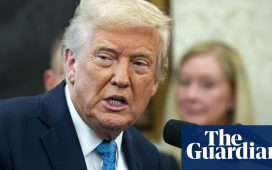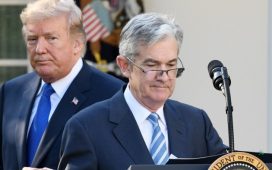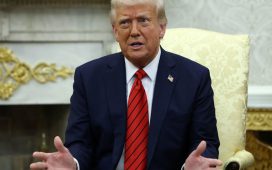One frustrating and entertaining thing about the Treasury market is that it’s Very Separate From the Monetary System until the US government needs money.
As it turns out, that’s been part of the market since the very beginning. An excellent new paper from Lev Menand and Josh Younger provides a thorough history of the government’s attempts to balance treating the Treasury market like public money and setting them conspicuously apart from the monetary system.
The academics point out that the primary dealer system is a key way the US government strikes this balance. Having a coterie of regulated private firms trade public debt allows officials to ensure robust liquidity in the market, while still reserving the ability to claim that it is private. Today there are 24 primary dealers, mostly owned by bank holding companies, that are required to bid at Treasury auctions and make markets in government debt.
It’s definitely worth reading the full paper, because the history is long (the modern version of the primary-dealer system was created in 1960) and we won’t be able to summarise the whole history here. But we can highlight some noteworthy points.
Historically, government-bond dealers have been trading firms, whether independent or part of a bank, with government support for their balance sheets. Providing that subsidy has long been controversial, according to Menand and Younger:
Accordingly, when it came to providing subsidised credit to government securities dealers, officials turned to Section 14. Section 14 authorises the Federal Reserve banks to “purchase and sell” a variety of securities “in the open market” (frequently referred to as open market operations) with a wide range of market participants — not just banks. On its face, Section 14 is not a lending authority. But in 1917, the Board struck on it as means to handle the unforeseen consequences of a provision in the War Revenue Act that levied a stamp tax on the promissory notes of banks. When applied to debt (including Treasury debt) used as collateral in exchange for short-term advances by the Reserve Banks, 210 the stamp tax made Reserve Bank advances uneconomic as a source of liquidity. This consequence threatened the stability of the government bond market, since subsidised lending to member banks to buy Treasuries was a significant component of public finance strategy at the time.
The Board — while awaiting a legislative fix — identified Section 14 as a workaround. The FRBs would purchase government debt under an agreement to resell it to the borrower fifteen days later at a slightly higher price — thus providing the economic equivalent of financing secured by the underlying bond but without the need to issue a promissory note (subject to the tax).
In other words, the Fed found a shortcut. Instead of providing money directly to Treasury dealers, they would simply turn Treasuries into money through repurchase agreements.
Repos briefly disappeared, but popped up again when the US government needed to provide liquidity to the market and facilitate smooth trading:
Although intended to support member banks, some FRBs began to use repurchase agreements also to finance non-member banks that held Liberty bonds . . . the Federal Reserve Bank of New York in particular looked to expand repo availability to non-bank dealers. The first such transaction secured by Treasury collateral occurred in April 1920 as part of a concerted effort to improve the functioning of the government bond market in anticipation of upcoming maturities of large wartime bond issues — and at rates noticeably below discounts at the time.
This new use sparked controversy, but after several years of struggle between Fed officials, in 1925, the Board reaffirmed its view that these transactions were legally authorised — in contrast to views previously expressed by its own General Counsel. The Fed’s use of this de facto lending power expanded into the early-1930s, driven by the Federal Reserve Bank of New York. Then, in 1933, the Fed suspended repo in Bills, and by 1935 it stopped the practice in government securities entirely. Repos were revived by the FOMC in the postwar interregnum that preceded the Accord. Their use was justified primarily to manage liquidity in the financial system — as one of the more effective tools by which to target free reserves and implement monetary policy. But there were other important motivations as well, including support for the intermediation of government securities.
Repo was especially helpful once the money-market fund was created in the 1970s:
Importantly, repo was also much more scalable — these transactions could be used to transform any of the more than $150 billion in marketable Treasury debt outstanding in the mid-1950s, not to mention corporate and other financial assets, into a deposit substitute from the point of view of the lender. It should come as little surprise, therefore, that the vast majority of repo funding for government securities dealers in those early years came from non-financial corporations. Although the Fed was an infrequent creditor to dealers, it was particularly important during periods of monetary tightness and therefore served as a liquidity backstop for the repo market more generally, rather than a regular source of funding . . .
In the 1970s, the pool of repo depositors at nonbank dealers expanded. The invention of the money market mutual fund (MMF) in 1972 (when the SEC approved the listing of the Reserve Fund) was a watershed moment. These new vehicles provided individual and corporate savers with streamlined and simplified access to short-term wholesale interest rates through a closed-end mutual fund organised under the Investment Company Act of 1940. In addition to essentially eliminating the operational burden of managing these portfolios — non-trivial in an over-the-counter market with many diverse counterparties and daily rollover requirements — they also provided same-day liquidity guarantees, which imbued MMF shares with even more explicit deposit-like features.
These money-market funds put another layer of privatisation on top of government-guaranteed money (bank reserves, insured deposits) and quasi-sovereign money (repo).
Of course, money-market funds are not actually backstopped by the US government the way insured deposits are, as Reserve Fund shareholders learned in 2008. More on that later.
Anyway, even money-market funds, under the super-explicitly-legislated auspices of the 1940 Investment Company Act, required some additional finagling before their holdings of repurchase agreements could be money-like.
Bankruptcy remoteness was particularly critical for MMF cash providers, which had offered their shareholders daily liquidity for redemptions, requiring immediate access to their investments. But in the early years this was just an assumption among market participants. Whether bankruptcy courts would treat repos as true sales was untested in practice.
One basic question remained in those early years: could a trader could follow through on a repo agreement (buying back the securities) if their counterparty had filed for bankruptcy? The presumption was yes for a while.
But a couple of judges decided in 1982 that those transactions were actually loans, and therefore couldn’t be repaid/repurchased if one of the parties went into bankruptcy. That didn’t go especially well for repo markets. Eventually then-Fed chair Paul Volcker was among those lobbying for repo to be exempt from the automatic stay on creditor payments, until Congress eventually passed a law carving repo transactions out:
The application of the automatic stay to repo positions meaningfully reduced the appeal of repos as an alternative to bank deposits. As creditors to the estate rather than owners of securities, repo cash providers would have to wait until the bankruptcy court authorised them to liquidate the assets (Treasuries or otherwise) securing their position. Not only would creditors lose access to some liquidity, but they would be exposed to fluctuations in the market value of their collateral for an indeterminant period. For money market funds and others looking for a money-like instrument, that was a serious problem. Conditions in repo markets quickly deteriorated. The twin rulings kicked off an intense debate over the appropriate treatment of repo in bankruptcy, and a lobbying effort to find a legislative solution . . .
Congress passed the Bankruptcy Amendments and Federal Judgeship Act of 1984, which explicitly exempted repos from the automatic stay. The result was a further step towards moneyness: explicit protection in bankruptcy. Although economically equivalent to a secured loan, repos were henceforth treated as a true sale when the cash borrower defaulted. Initially limited to US government obligations and other highly liquid securities, these carve-outs were eventually extended to mortgage and mortgage-related securities — including, fatefully, collateralised debt obligations constructed from mortgage-backed securities.
Whoops!
Anyway, this arrangement worked for a while, then unravelled in 2008 thanks to the influx of junky mortgage-related repo collateral that was rendered nearly worthless when Lehman Brothers fell.
Major banks merged, and suddenly most of the primary dealers were part of bank holding companies, whose capital bases and sizes were now regulated far more intensely than they were before the global financial crisis.
Though smaller dealers remained independent (eg, Jefferies, Cantor Fitzgerald), for the first time in modern financial history the majority of dealer activity was performed within BHCs. Accordingly, this large share of dealer activity was subject to bank regulations, including an earlier generation of internationally agreed requirements (known as Basel II) as implemented by the Federal Reserve.
This is why everyone was worried about Treasury market liquidity for a while. The post-crisis Basel regulations made it less profitable to trade Treasuries than other riskier products (comparing cost of capital vs return on equity, at least) and limited the amount of Treasuries that it made sense for now-bank-dealers to hold.
At the same time, Treasury issuance continued to grow. So instead of banks, the extra paper went to prop-trading firms, money managers and hedge funds, the academics say:
Cash/Treasuries basis trades, which are most commonly constructed as a “short” in futures and a repo financed “long” in one or several bonds from that contract’s deliverable basket, rely on leverage but have a theoretically bounded pay-off with minimal market risk in a relatively wide range of market conditions. That made them fit for purpose as a place holder position to secure future access to balance sheet as needed.
To explain, trading firms and hedge funds perform leveraged arbitrage between different Treasury markets and maturities. One popular strategy is the “basis trade”, which helps maintain price relationships between Treasuries and futures contracts. Another is “relative value” trades, which arbitrage price relationships between different points on the Treasury yield curve.
In theory, this shouldn’t be much of a problem. Most post-GFC regulation has been built on the view that end investors aren’t systemically important, because they aren’t intermediaries for the whole dang financial system. Banks are, because of their role as franchise money creators for the government.
The flaw with that is, these arbitrage strategies blew up in 2020, and the entire Treasury market went haywire for weeks. And unlike other markets, there are big consequences if the Treasury market goes off the rails given its benchmark status. (While the authors of the paper use the 2014 flash rally in Treasuries as an example of arbitrageurs stepping back, at least one primary dealer told the press they turned off their computers when the flash rally started. And primary dealers have only explicitly been required to make markets in Treasuries since 2016, months after Alphaville pointed out there wasn’t a requirement.)
The basis trade collapsed for a while after the 2020 ructions, but is “probably” surging in popularity again now, as a couple of Fed analysts wrote in an August 30 paper.
So Younger and Menand make the case, like Darrell Duffie did in his Jackson Hole paper, that Treasury-market liquidity should be explicitly supported by the Federal Reserve:
Treasury dealing could be supported by direct access to Fed liquidity and federal deposit insurance. The result would be stable, low-cost funding that allows for a much nimbler and more elastic dealer complex on the one hand, and strong incentives to bring this activity back inside the bank regulatory perimeter, which comes with extensive disclosure and supervisory oversight, on the other. This was presumably what legislators had in mind when they specifically exempted dealing in government securities from the separation of dealing and commercial banking in the Banking Act of 1933.
They suggest carving out exemptions for a special class of government-bond-dealer bank subsidiaries to keep Treasury trading within the regulated banking system.
This may not go far enough. Treasuries have been implicit government money since the Civil War, the academics argue. And they themselves show that government bond dealers have not historically been within the banking system.
So why spend resources on nominating and subsidising firms to provide liquidity if the Fed can achieve that goal on its own? The US could simply give the Fed the authority to intervene in markets for the purpose of maintaining stability and liquidity, which was raised as a possibility in Duffie’s proposal.
Harvard’s Jeremy Stein had reservations, as he discussed in a response to Duffie’s Jackson Hole paper:
Which brings me to a final tool which Darrell emphasised, outright Fed purchases for market-function objectives. So let me start with two points of agreement: (i) clearly, as Darrell shows, such purchases can be a powerful tool when dealer capacity is strained; and (ii) one absolutely does not want to take such a tool off the table. But in my view, it should ideally be used as something of a last resort; I would rather see us do everything we can with respect to easing artificial capacity constraints, and broadening access to repo before turning to purchases. These are both considerably lighter-footprint interventions, and also have the benefit of not creating any confusion between a market-function policy intervention as opposed to one that is being used for monetary-policy purposes.
Nevertheless, central bank purchases are likely to remain an important piece of the arsenal for dealing with market function in extreme cases. That said, one issue is how one talks about them, if at all, ahead of time. In the last line of Darrell’s paper, he writes: “Backstopping the liquidity of this market with transparent official-sector purchase programs will further buttress market resilience.” This sentence is worth unpacking. Does transparent mean that the Fed should communicate ex ante the circumstances under which it will intervene in the market? Or more modestly, that when it does intervene, it ex post says loudly and clearly, “these are market function purchases, not monetary policy purchases, and so don’t expect us to hold on to the bonds for too long, and don’t draw any inferences whatsoever about the stance of monetary policy”?
His hesitation seems relatively easy to address, since the Fed could in theory do both of his suggestions above. But as Younger and Menand write in their paper, the US has aimed to take a “light touch” in its bond markets since the days of ur-central banker Alexander Hamilton, so there may be a cultural hangup here.
Still, recent years’ market malfunctions show that practice could be worth some thought. Especially given the number of rent-collecting middlemen put into service of disguising the US government’s involvement in its own debt market.









